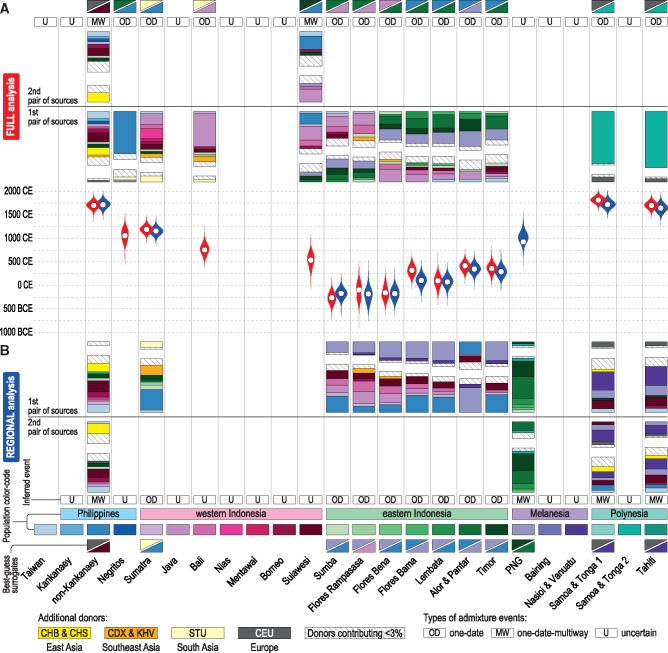Fig. 4.
Population admixture events and inferred contact dates as inferred by the main GT analysis. Individual raw FS populations were grouped into larger population clusters (see fineSTRUCTURE results, fig. 3B and supplementary fig. S1 and table S1, Supplementary Material online) for the GLOBETROTTER analysis. Inferred admixture events were classified into three types: one-date admixture (OD, involving a pair of mixing sources); one-date-multiway admixture (MW, involving two pairs of mixing sources); and uncertain (U). The inferred composition of mixing sources is shown as barplots (one pair for OD and two pairs for MW). A pair of “best-guess” surrogate populations that matches the inferred contributing sources for the primary admixture event are shown as shaded triangles. The bean plots in the center depict the distributions of admixture dates as estimated by 100 bootstrap replicates. Dates inferred by “full” and “regional” analysis are colored in red and blue, respectively. White circles represent point estimates of the date of admixture. The color scheme assigned to the additional mainland East Asian (CHB and CHS), Southeast Asian (CDX and KHV), South Asian (STU), and European (CEU) surrogates is shown at the bottom of the plot. Surrogates contributing <3% to mixing sources are hatched in grey. Detailed information about the inferred admixture events and composition of mixing sources is given in supplementary table S3, Supplementary Material online. (A) Results of the “full” analysis. Each target population was allowed to copy from all donor populations, excluding self-copying from its own group. (B) Results of the “regional” analysis. Populations were divided into five geographical regions: the Philippines, western Indonesia, eastern Indonesia, Melanesia, and Polynesia (fig. 1A and supplementary table S1, Supplementary Material online). Each target group was allowed to copy from all donor populations, excluding populations with the same regional label (supplementary table S4, Supplementary Material online).

